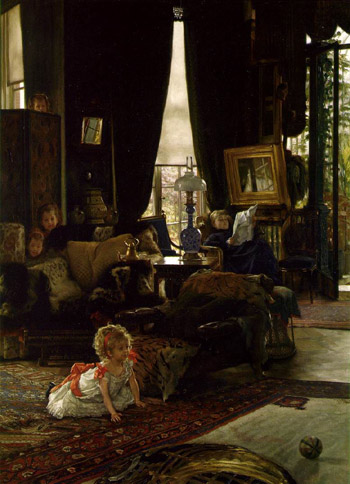| Search Art Prints | ||||||||||||||||||||
| Search Artists | ||||||||||||||||||||

|
||||||||||||||||||||
|
|
|||||||||||||||||||

Hide and Seek

|
Hide and Seek
It was in 1877 that renowned, high society painter James Tissot created ‘Hide and Seek’, an oil painting that could be deemed a photographic replica of an ongoing game of ‘hide and seek’ in the artist’s home studio. The young child in the white dress on the floor was believed to be Tissot’s son, but dating and research revealed that the child was actually his daughter. The other children are most likely her young cousins who lived next door to the Tissot family. Tissot’s companion Kathleen Newton, the toddler’s mother, is reading a newspaper while the children play.
When examining James Tissot’s meticulous work in reproducing the numerous details of his studio, one can almost feel the subtle texture of the fur that lies on the sofa, and the smoothness of the ceramic vases on the right. Tissot used fine brush strokes to soften the color and texture of his daughter’s silky golden hair. The light that gently cascades into the room from the window and door infuses the viewer with a sense of calm and serenity. However, while the painting is a comforting reflection of daily activities in the Tissot’s home, the artist inserts a small measure of unease to the scene by adding a dark Japanese mask on the wall near Kathleen. The children peering out from their hiding places also create a somewhat eerie atmosphere.
Review
Hall Groat II who reviewed the 1999 exhibition, “James Tissot: Victorian Life/Modern Love, wrote the following: “Tissot painted with an academic tightness of execution and great attention to detail. In this way, he created his own uniquely modern way of seeing, melding traditional techniques with new subject matter. French collectors admired this skilful mixture.”
‘Hide and Seek’ by James Tissot is currently located at the National Gallery of Art, Washington DC, USA











